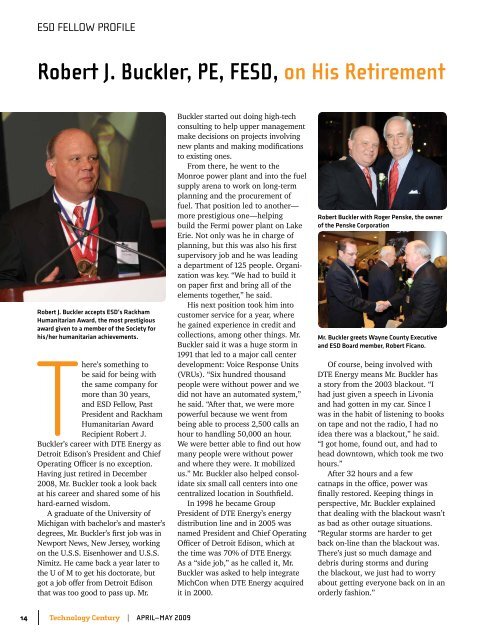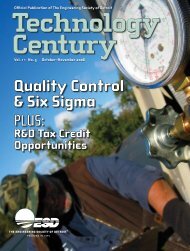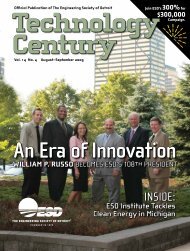YouTube Science & Engineering Camps for Kids - ESD
YouTube Science & Engineering Camps for Kids - ESD
YouTube Science & Engineering Camps for Kids - ESD
Create successful ePaper yourself
Turn your PDF publications into a flip-book with our unique Google optimized e-Paper software.
<strong>ESD</strong> FELLOW PROFILE<br />
Robert J. Buckler, PE, F<strong>ESD</strong>, on His Retirement<br />
Robert J. Buckler accepts <strong>ESD</strong>’s Rackham<br />
Humanitarian Award, the most prestigious<br />
award given to a member of the Society <strong>for</strong><br />
his/her humanitarian achievements.<br />
here’s something to<br />
be said <strong>for</strong> being with<br />
the same company <strong>for</strong><br />
more than 30 years,<br />
and <strong>ESD</strong> Fellow, Past<br />
President and Rackham<br />
Humanitarian Award<br />
Recipient Robert J.<br />
Buckler’s career with DTE Energy as<br />
Detroit Edison’s President and Chief<br />
Operating Officer is no exception.<br />
Having just retired in December<br />
2008, Mr. Buckler took a look back<br />
at his career and shared some of his<br />
hard-earned wisdom.<br />
A graduate of the University of<br />
Michigan with bachelor’s and master’s<br />
degrees, Mr. Buckler’s first job was in<br />
Newport News, New Jersey, working<br />
on the U.S.S. Eisenhower and U.S.S.<br />
Nimitz. He came back a year later to<br />
the U of M to get his doctorate, but<br />
got a job offer from Detroit Edison<br />
that was too good to pass up. Mr.<br />
Buckler started out doing high-tech<br />
consulting to help upper management<br />
make decisions on projects involving<br />
new plants and making modifications<br />
to existing ones.<br />
From there, he went to the<br />
Monroe power plant and into the fuel<br />
supply arena to work on long-term<br />
planning and the procurement of<br />
fuel. That position led to another—<br />
more prestigious one—helping<br />
build the Fermi power plant on Lake<br />
Erie. Not only was he in charge of<br />
planning, but this was also his first<br />
supervisory job and he was leading<br />
a department of 125 people. Organization<br />
was key. “We had to build it<br />
on paper first and bring all of the<br />
elements together,” he said.<br />
His next position took him into<br />
customer service <strong>for</strong> a year, where<br />
he gained experience in credit and<br />
collections, among other things. Mr.<br />
Buckler said it was a huge storm in<br />
1991 that led to a major call center<br />
development: Voice Response Units<br />
(VRUs). “Six hundred thousand<br />
people were without power and we<br />
did not have an automated system,”<br />
he said. “After that, we were more<br />
powerful because we went from<br />
being able to process 2,500 calls an<br />
hour to handling 50,000 an hour.<br />
We were better able to find out how<br />
many people were without power<br />
and where they were. It mobilized<br />
us.” Mr. Buckler also helped consolidate<br />
six small call centers into one<br />
centralized location in Southfield.<br />
In 1998 he became Group<br />
President of DTE Energy’s energy<br />
distribution line and in 2005 was<br />
named President and Chief Operating<br />
Officer of Detroit Edison, which at<br />
the time was 70% of DTE Energy.<br />
As a “side job,” as he called it, Mr.<br />
Buckler was asked to help integrate<br />
MichCon when DTE Energy acquired<br />
it in 2000.<br />
Robert Buckler with Roger Penske, the owner<br />
of the Penske Corporation<br />
Mr. Buckler greets Wayne County Executive<br />
and <strong>ESD</strong> Board member, Robert Ficano.<br />
Of course, being involved with<br />
DTE Energy means Mr. Buckler has<br />
a story from the 2003 blackout. “I<br />
had just given a speech in Livonia<br />
and had gotten in my car. Since I<br />
was in the habit of listening to books<br />
on tape and not the radio, I had no<br />
idea there was a blackout,” he said.<br />
“I got home, found out, and had to<br />
head downtown, which took me two<br />
hours.”<br />
After 32 hours and a few<br />
catnaps in the office, power was<br />
finally restored. Keeping things in<br />
perspective, Mr. Buckler explained<br />
that dealing with the blackout wasn’t<br />
as bad as other outage situations.<br />
“Regular storms are harder to get<br />
back on-line than the blackout was.<br />
There’s just so much damage and<br />
debris during storms and during<br />
the blackout, we just had to worry<br />
about getting everyone back on in an<br />
orderly fashion.”<br />
14 | Technology Century | APRIL–MAY 2009
















